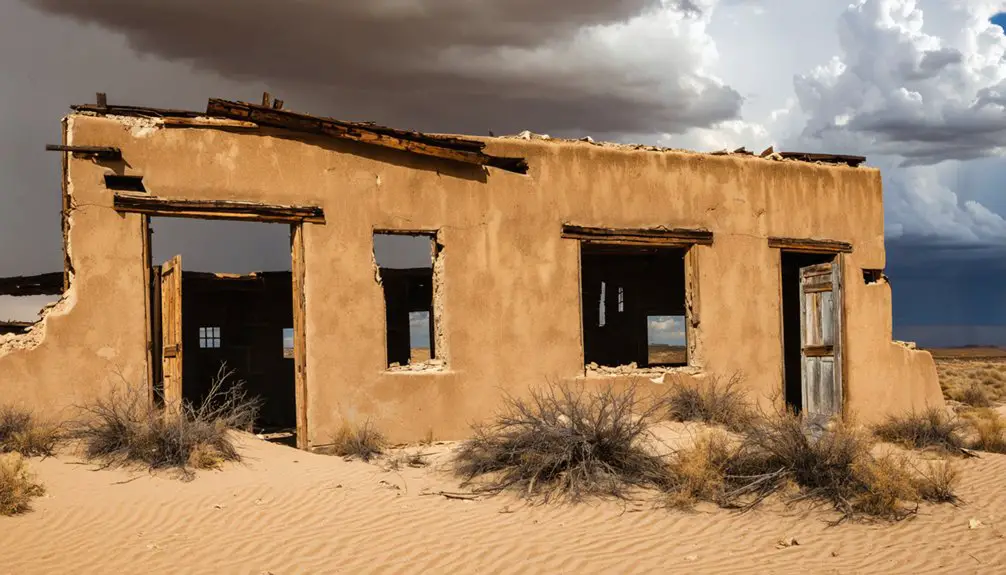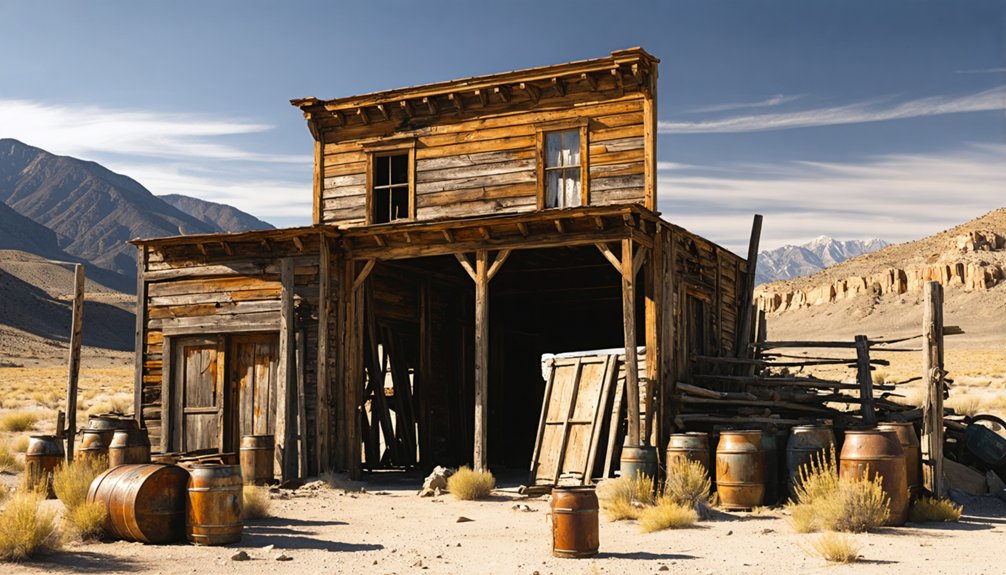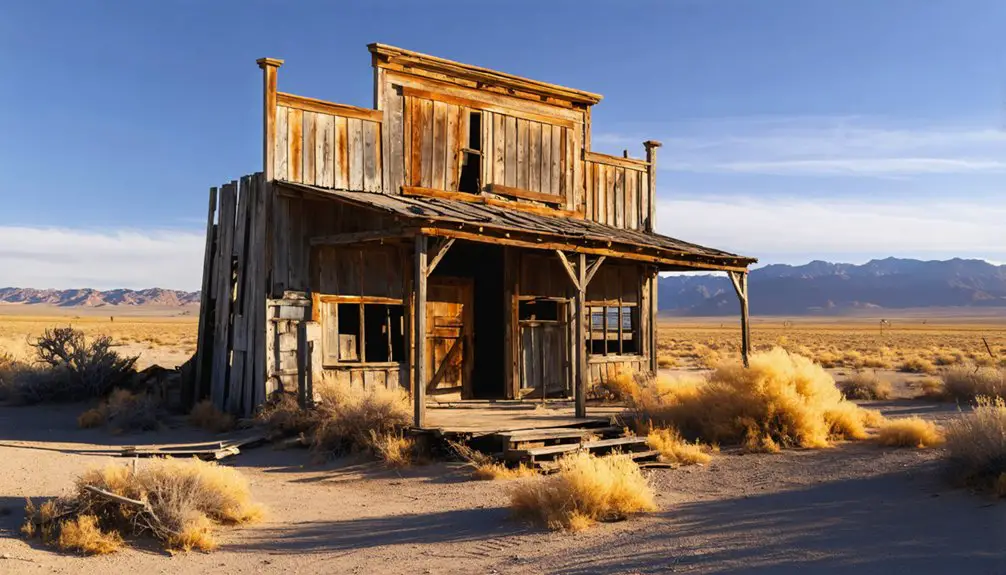You’ll discover a classic Nevada boom-and-bust tale in Rawhide, where gold’s discovery on Christmas Day 1906 transformed barren desert into an 8,000-person metropolis. Despite $2 million in mining production, the town couldn’t survive a devastating 1908 fire and 1909 flood. By the 1960s, only one resident remained – Mrs. Anne Rechel – and today, just scattered remnants hint at the dramatic story of speculation, wealth, and ultimate decline that shaped this frontier outpost.
Key Takeaways
- Rawhide emerged after a Christmas 1906 gold discovery, rapidly growing to 8,000 residents by 1908 as a bustling mining frontier town.
- The town’s mining operations produced nearly $2 million in gold and silver before its decline, with significant placer gold extraction.
- A devastating fire in 1908 and flood in 1909 destroyed much of the town, causing population to plummet from 7,000 to 500.
- Transportation challenges and incomplete railway infrastructure limited ore processing capabilities and hindered the town’s long-term growth potential.
- By the 1980s, all physical traces of Rawhide disappeared except its stone jail, which was relocated to Hawthorne.
The Discovery That Started It All
While many Nevada mining towns began with a single dramatic strike, Rawhide’s story started on Christmas Day 1906, when prospector Jim Swanson discovered gold in the region’s rugged hills.
You’ll find that this now-famous ghost town’s mining history quickly expanded when fellow prospectors Charles Holman and Scott McLeod joined Swanson, discovering additional rich deposits near “Hooligan Hill.” Together, they uncovered a network of veins containing both gold and silver, setting the stage for what would become a bustling mining district. The site required careful content verification links to distinguish it from other locations sharing the Rawhide name. By June 1908, the booming settlement had grown to include a population of eight thousand residents.
From Desert to Boomtown: The Rush to Rawhide
As news of Swanson’s Christmas Day discovery spread through Nevada’s mining circles, Rawhide transformed from a barren desert outpost into a booming frontier metropolis.
By mid-1908, you’d have found yourself among 7,000 fortune seekers in a town that seemed to materialize overnight. The once-empty desert now boasted 40 saloons, 28 hotels, and modern conveniences that rivaled any established city. The devastating September 4th fire would soon mark the beginning of the town’s decline.
You’d have rubbed shoulders with characters like Tex Rickard, who’d later found Madison Square Garden, and “Swiftwater” Gates fresh from Alaska’s goldfields.
The newly constructed Rawhide Western Railway connected you to neighboring towns, while mining techniques evolved to extract the precious ore. Residents paid dearly for basic necessities, with water costing 5 cents per gallon.
But like many Nevada ghost towns, Rawhide’s explosive growth was fueled more by speculation and stock manipulation than actual mineral wealth.
Life in a Mining Metropolis
During its brief heyday in 1908, Rawhide buzzed with the constant activity of 7,000 residents who’d created a surprisingly sophisticated frontier metropolis.
You’d find more than 40 saloons and 28 hotels serving the bustling community, while modern conveniences made life comfortable for settlers and speculators alike.
The community dynamics reflected classic boomtown contrasts. While churches tried to maintain moral order, a thriving red light district catered to wilder pursuits. Located at 5,082 feet elevation, the town sat high in Nevada’s mineral-rich landscape.
Like most mining boomtowns, Rawhide balanced precariously between sacred and sinful, with churches and brothels competing for souls.
Notable figures like Tex Rickard, who ran the Northern Saloon, and “Diamondfield” Jack Davis added to the town’s colorful character.
Despite the transient lifestyle of most residents, essential services like the post office helped maintain a sense of permanence.
You could witness both the refined and rough elements of frontier life coexisting in this briefly booming desert town.
The Railway and Transportation Revolution
You’ll find that Rawhide’s transportation story began with ambitious plans for the Rawhide Western Railway in 1908, which aimed to connect the booming mining town to regional rail networks near Schurz.
While the railway’s construction stalled due to the devastating September 1908 fire and eventual bankruptcy, the town adapted by introducing automobiles to haul precious ore to railheads in Fallon, Schurz, and Luning. Like the Carson & Colorado Railway, this unfinished railroad project demonstrated the vital role transportation infrastructure played in Nevada’s mining communities.
The mining town’s population of 7,000 in 1908 highlighted the pressing need for efficient transportation systems to support its rapid growth and development. The incomplete railroad infrastructure ultimately hindered Rawhide’s growth and competitiveness compared to other Nevada mining towns that maintained active rail connections to major transportation corridors.
Rail Network Development
While Rawhide’s gold rush peaked in 1907-1908, the construction of the Rawhide Western Railway provided an essential transportation link between the booming town and the Nevada-California Railroad at Schurz.
You’ll find that the railway’s completion helped transform Rawhide into a modern boomtown of 8,000 residents, with thriving businesses and hotels. Following the discovery by Jim Swanson’s strike, the town rapidly grew to accommodate the influx of miners and prospectors.
Despite its importance, the railway faced significant challenges. The belated rail development limited early transport advantages, and the devastating 1908 fire severely impacted operations. Similar to other mining regions, high transportation costs severely limited ore processing capabilities.
Economic integration proved difficult due to the high costs of connecting to broader rail networks. While promoters from Goldfield invested heavily in the infrastructure, the railway’s financial viability suffered from Rawhide’s relatively low total production of just $2 million and the town’s rapid decline by 1910.
Automobile Mining Transport
Automobiles revolutionized ore hauling in Rawhide by 1908, offering miners a flexible alternative to traditional horse-drawn wagons. You’ll find that these early automobile logistics changed how mining operations connected to essential railheads in Fallon, Schurz, and Luning, though they didn’t completely replace other transport methods.
While these mining innovations brought new freedoms to ore transport, they weren’t without challenges. You’d to contend with mechanical issues on rough roads, limited fuel supplies in remote areas, and smaller carrying capacity compared to rail transport. The expensive cost of fifty cents per gallon for water from Dead Horse Well made maintaining vehicles particularly challenging.
Still, automobiles proved invaluable by reaching areas where railroads couldn’t go, creating an integrated network that supported Nevada’s mining economy. The combination of automotive and rail transport helped sustain production even when weather, terrain, or construction delays threatened to slow operations.
Ore Transportation Methods
As Rawhide’s mining operations expanded in the early 1900s, the development of the Rawhide Western Railway from Schurz to Stingaree Gulch marked a significant change in ore transportation methods.
You’ll find that before the railway’s arrival, mining companies relied heavily on automobiles and wagons to haul ore to distant railheads in Fallon, Schurz, and Luning.
The railway revolutionized ore logistics by providing a direct route for mineral transport, though it arrived after the initial rush.
- Railway construction boosted Rawhide’s rapid growth and economic activity
- Transportation efficiency improved dramatically compared to road-based methods
- Combined transport systems operated briefly during the conversion period
- The railway enabled higher ore volumes despite total production under $2 million
- Fire damage and limited yields eventually led to the railway’s abandonment
Stock Promotions and Mining Speculation
During Rawhide’s brief heyday, stock promoters capitalized on the region’s gold discoveries through elaborate marketing schemes and ornate stock certificates. Companies like Rawhide Mining Company and Saturn Mining Company mastered stock manipulation by issuing beautifully engraved certificates bearing prominent signatures, including A. A. Codd and George Wingfield.
You’ll find that investor psychology played a significant role in Rawhide’s speculation boom. While real gold and silver deposits existed, promoters exploited the “next big thing” narrative to inflate values far beyond actual mining yields.
Companies issued up to a million shares each, with brokers and promoters profiting handsomely at common shareholders’ expense. Notable firms like Rawhide Free Gold Mining Company extended their reach as far as Seattle, demonstrating how this Nevada boomtown’s promotional tentacles stretched well beyond its dusty borders.
Natural Disasters Strike

While Rawhide had flourished as Nevada’s newest boomtown in early 1908, two devastating natural disasters would soon seal its fate.
In September of that year, a massive fire consumed a third of a mile of wooden buildings, crippling the town’s infrastructure. Just when recovery seemed possible, a destructive flood struck in September 1909, delivering the final blow to Rawhide’s hopes for survival.
- You’ll find the economic impact was swift and severe, as mining revenues plummeted.
- You’d have witnessed investors fleeing, including abandonment of the nearly-complete Rawhide Western Railroad.
- Within two years, the population plunged from 7,000 to fewer than 500 residents.
- The disasters forced the closure of newly opened mills by 1909.
- You can trace Rawhide’s transformation into a ghost town directly to these catastrophic events.
The Slow Fade Into History
If you’d visited Rawhide in the 1960s, you’d have found just one permanent resident, Mrs. Anne Rechel, who remained as the town’s final holdout until the late 1960s.
The town’s last physical traces disappeared in the 1980s when Kennecott Rawhide Mining Company’s operations consumed the original townsite, though the stone jail was saved and moved to Hawthorne.
While modern mining erased most visible remnants of this once-bustling boomtown, Rawhide’s legacy continues through historical records and its preserved cemetery, located a mile north of today’s mining area.
Final Residents Fade Away
As Rawhide’s promising ore deposits dwindled in the early 1900s, its once-bustling population of 7,000 rapidly shrank to fewer than 500 residents by late 1910.
You’d have witnessed a stark community decline through the following decades, with the 1941 post office closure signaling the town’s fading pulse.
In Rawhide’s final years, Anne Rechel stood as the last true resident until the late 1960s, marking the end of an era.
- The 1908 fire devastated large portions of the town
- A 1909 flood further damaged remaining infrastructure
- By the 1920s, nearly all residents had sought opportunities elsewhere
- Only occasional mining workers passed through during later decades
- The 1980s open-pit mining operations erased the last physical traces of the townsite
Mining Legacy Lives On
Though Rawhide’s physical remnants have largely vanished, the town’s mining legacy endures through its significant contribution to Nevada’s mineral production history.
You’ll find that between 1906 and 1930, miners extracted up to $250,000 in placer gold, with total production reaching nearly $2 million. The mining techniques used to work the gold-silver quartz veins in Tertiary volcanic rocks helped establish early standards for Nevada mining operations.
Today, this ghost town’s story lives on through the preserved stone jail in Hawthorne and the documented tales of innovative ore transport using early automobiles.
While Kennecott Rawhide Mining Company’s modern operations have erased most original structures, Rawhide’s brief but intense mining boom represents a classic example of Nevada’s dynamic mineral rush era.
Mrs. Rechel: The Last Resident

Anna Frances Elleser Rechel stood as the last guardian of Rawhide, Nevada until her death in 1967.
You’ll find her story embodies the fierce independence of early women prospectors who carved their own path in the American West. Even as Rawhide transformed into a ghost town around her, she refused to abandon her desert home despite her family’s concerns.
- Lived as a solo prospector and miner in male-dominated 1900s Nevada
- Maintained her residence while the town crumbled into ruins
- Repeatedly returned to Rawhide when family tried relocating her
- Chose the rugged outdoor lifestyle until her final days
- Left a legacy as a symbol of pioneering spirit and determination
Her departure marked Rawhide’s final shift from living community to true ghost town, before modern mining operations eventually erased the original townsite.
Mining Production and Economic Impact
Despite official records showing modest production of $34,800, Rawhide’s actual mining output between 1907-1930 likely reached $200,000 to $250,000 in placer deposits alone.
While official records claimed minimal yields, Rawhide’s true mining production was likely six times higher in placer deposits.
You’ll find the total production, including lode and placer gold, didn’t exceed $2 million, despite the town’s explosive growth to 8,000 residents.
The economic fluctuations were dramatic – over 40 saloons and 28 hotels sprang up as mining technology advanced with cyanide plants and rail connections.
Yet, much of Rawhide’s prominence came from aggressive promotion rather than sustained ore production.
The devastating 1908 fire dealt a severe blow, and though new mills operated briefly in 1909, they couldn’t maintain profitability.
Stock manipulation enriched promoters while leaving most investors empty-handed, leading to the town’s eventual economic collapse.
Modern Remnants and Historical Legacy

When you visit Rawhide today, you’ll find virtually nothing of the original boomtown remains, as modern mining operations have completely transformed the landscape.
Only the small cemetery and the relocated jail in Hawthorne serve as tangible reminders of this once-thriving community. The devastating 1908 fire and 1909 flood dealt severe blows to the town’s physical structures, while the post office’s closure in 1941 marked the beginning of its final decline.
- Peak population reached 7,000-8,000 during the 1908 boom
- Over 40 saloons and 28 hotels once lined the streets
- A ten-foot wall of water destroyed 130 buildings in the 1909 flood
- The original jail now stands preserved in Hawthorne
- Ghost town exploration continues despite limited physical remains
Frequently Asked Questions
What Was the Average Daily Wage for Miners in Rawhide?
While mining wages could’ve made you feel like a millionaire, you’d typically earn $2-$5 daily in Rawhide’s harsh labor conditions, though exact rates varied based on your skill and production levels.
Were There Any Famous Outlaws or Gunfights in Rawhide’s History?
You’ll find few famous outlaws in Rawhide’s short history, except for “Swiftwater” Gates and “Diamondfield” Jack Davis. The town’s only notable gunfight legend involves Maxwell and Walters’ 1908 stagecoach robbery.
What Happened to the Gold Discovered After the Town Was Abandoned?
You’ll find most gold deposits were mined out before abandonment, though Kennecott Rawhide Mining Company later recovered some ore through modern methods, ultimately destroying the original townsite during their gold recovery operations.
Did Any Notable Historical Figures Ever Visit Rawhide During Its Peak?
You won’t find records of any famous visitors or notable historical figures in Rawhide during its 1907-1908 peak. The town attracted business promoters and prospectors, but no documented dignitaries.
What Were Typical Food Prices in Rawhide’s Restaurants and Grocery Stores?
You’d find food variety was expensive, with basic meals likely costing several times city prices. Water at 50 cents per gallon made dining experiences pricey, though saloons offered competitive food deals.
References
- https://en.wikipedia.org/wiki/Rawhide
- https://www.nevadaappeal.com/news/2019/jan/29/toasting-the-ghosts-of-rawhide/
- https://kids.kiddle.co/Rawhide
- https://www.nvexpeditions.com/mineral/rawhide.php
- https://www.youtube.com/watch?v=mqxMpF_uPd0
- https://yesterdaystrails.wordpress.com/2021/03/18/gt019-ghost-town-of-rawhide-nevada-may-1964/
- https://www.destination4x4.com/rawhide-nevada-ghosttown/
- https://westernmininghistory.com/towns/nevada/rawhide/
- https://bikepackingnv.substack.com/p/the-great-nevada-railroad-bazaar
- https://tchistory.org/railroad-transportation/



